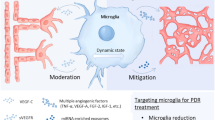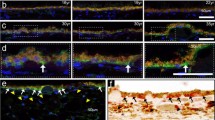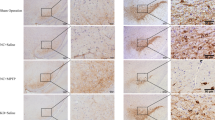Abstract
Microglia-associated inflammation is closely related to the pathogenesis of retinal degenerative disorders. We have previously shown in vivo that naloxone protected photoreceptors from light-induced apoptosis possibly through inhibiting microglial activation. In this study, we attempted to explore the effect of lipopolysaccharide (LPS)-activated microglia on photoreceptor death and the influence of naloxone treatment using an in vitro retinal microglia and 661 W photoreceptor co-culture system. Immunofluorescent staining and ELISA measurements demonstrated that LPS activated microglia by changing the morphology and increasing the production of proinflammatory factors interleukin (IL)-1beta and tumor necrosis factor (TNF)-alpha. Flow cytometry analysis of annexin V/propidium iodide staining showed that LPS-activated microglia promoted the apoptosis of co-cultured 661 W photoreceptor cells. Naloxone inhibited microglial activation and decreased the release of IL-1beta and TNF-alpha but could not prevent photoreceptors from undergoing apoptosis. Considering the dual role of microglia-associated inflammation in both neurotoxicity and neuroprotection, modulating the function, rather than simply inhibiting their activation, might be a new therapeutic method for preventing photoreceptor degeneration.






Similar content being viewed by others
REFERENCES
Donoso, L.A., D. Kim, A. Frost, A. Callahan, and G. Hageman. 2006. The role of inflammation in the pathogenesis of age-related macular degeneration. Survey of Ophthalmology 51: 137–152.
Komeima, K., B.S. Rogers, L. Lu, and P.A. Campochiaro. 2006. Antioxidants reduce cone cell death in a model of retinitis pigmentosa. Proceedings of the National Academy of Sciences of the United States of America 103: 11300–11305.
Kreutzberg, G.W. 1996. Microglia: a sensor for pathological events in the CNS. Trends in Neurosciences 19: 312–318.
Chao, C.C., S. Hu, L. Ehrlich, and P.K. Peterson. 1995. Interleukin-1 and tumor necrosis factor-synergistically mediate neurotoxicity: involvement of nitric oxide and of N-methyl-d-aspartate receptors. Brain, Behavior, and Immunity 9: 355–365.
McGuire, S.O., Z.D. Ling, J.W. Lipton, C.E. Sortwell, T.J. Collier, and P.M. Carvey. 2001. Tumor necrosis factor alpha is toxic to embryonic mesencephalic dopamine neurons. Experimental Neurology 169: 219–230.
Zeng, H.Y., X.A. Zhu, C. Zhang, L.P. Yang, L.M. Wu, and M.O. Tso. 2005. Identification of sequential events and factors associated with microglial activation, migration, and cytotoxicity in retinal degeneration in rd mice. Investigative Ophthalmology & Visual Science 46: 2992–2999.
Zhang, C., J.K. Shen, T.T. Lam, H.Y. Zeng, S.K. Chiang, F. Yang, and M.O. Tso. 2005. Activation of microglia and chemokines in light-induced retinal degeneration. Molecular Vision 11: 887–895.
Lund, S., K.V. Christensen, M. Hedtjärn, A.L. Mortensen, H. Hagberg, J. Falsig, H. Hasseldam, A. Schrattenholz, P. Pörzgen, and M. Leist. 2006. The dynamics of the LPS triggered inflammatory response of murine microglia under different culture and in vivo conditions. Journal of Neuroimmunology 180: 71–87.
Yamada, K., Y. Komori, T. Tanaka, K. Senzaki, T. Nikai, H. Sugihara, T. Kameyama, and T. Nabeshima. 1999. Brain dysfunction associated with an induction of nitric oxide synthase following an intracerebral injection of lipopolysaccharide in rats. Neuroscience 88: 281–294.
Qin, L., X. Wu, M.L. Block, Y. Liu, G.R. Breese, J.S. Hong, D.J. Knapp, and F.T. Crews. 2007. Systemic LPS causes chronic neuroinflammation and progressive neurodegeneration. Glia 55: 453–462.
Yang, L.P., X.A. Zhu, and M.O. Tso. 2007. A possible mechanism of microglia–photoreceptor crosstalk. Molecular Vision 13: 2048–2057.
Liu, B., J.W. Jiang, B.C. Wilson, L. Du, S.N. Yang, J.Y. Wang, G.C. Wu, X.D. Cao, and J.S. Hong. 2000. Systemic infusion of naloxone reduces degeneration of rat substantia nigral dopaminergic neurons induced by intranigral injection of lipopolysaccharide. Journal of Pharmacology and Experimental Therapeutics 295: 125–132.
Liu, B., L. Du, L.Y. Kong, P.M. Hudson, B.C. Wilson, R.C. Chang, H.H. Abel, and J.S. Hong. 2000. Reduction by naloxone of lipopolysaccharide-induced neurotoxicity in mouse cortical neuron-glia co-cultures. Neuroscience 97: 749–756.
Dobrenis, K., M.H. Makman, and G.B. Stefano. 1995. Occurrence of the opiate alkaloid-selective mu3 receptor in mammalian microglia, astrocytes and Kupffer cells. Brain Research 686: 239–248.
Ni, Y.Q., G.Z. Xu, W.Z. Hu, L. Shi, Y.W. Qin, and C.D. Da. 2008. Neuroprotective effects of naloxone against light-induced photoreceptor degeneration through inhibiting retinal microglial activation. Investigative Ophthalmology & Visual Science 49: 2589–2598.
Wang, A.L., A.C. Yu, L.T. Lau, C. Lee, M. le Wu, X. Zhu, and M.O. Tso. 2005. Minocycline inhibits LPS-induced retinal microglia activation. Neurochemistry International 47: 152–158.
Al-Ubaidi, M.R., R.L. Font, A.B. Quiambao, M.J. Keener, G.I. Loiu, P.A. Overbeek, and W. Baehr. 1992. Bilateral retinal and brain tumors in transgenic mice expressing simian virus 40 large T antigen under control of the human interphotoreceptor retinoid-binding protein promoter. The Journal of Cell Biology 119: 1681–1687.
Tan, E., X. Ding, N. Agarwal, M.I. Naash, and M.R. Al-Ubaidi. 2004. Expression of cone-photoreceptor-specific antigens in a cell line derived from retinal tumors in transgenic mice. Investigative Ophthalmology & Visual Science 45: 764–768.
Roque, R.S., A.A. Rosales, L. Jingjing, N. Agarwal, and M.R. Al-Ubaidi. 1999. Retina-derived microglial cells induce photoreceptor cell death in vitro. Brain Research 836: 110–119.
Streit, W,J.1995. Microglial cells. In: Kettenmann HaR, BR. Neuroglia. Oxford University Press, New York.
Streit, W.J. 2002. Microglia as neuroprotective, immunocompetent cells of the CNS. Glia 40: 133–139.
Gupta, N., K.E. Brown, and A.H. Milam. 2003. Activated microglia in human retinitis pigmentosa, late-onset retinal degeneration, and age-related macular degeneration. Experimental Eye Research 76: 463–471.
Dickson, D.W., S.C. Lee, L.A. Mattiace, S.H. Yen, and C. Brosnan. 1993. Microglia and cytokines in neurological disease, with special reference to AIDS and Alzheimer's disease. Glia 7: 75–83.
Pang, Y., L. Campbell, B. Zheng, L. Fan, Z. Cai, and P. Rhodes. 2010. Lipopolysaccharide-activated microglia induce death of oligodendrocyte progenitor cells and impede their development. Neuroscience 166: 464–475.
Lu, X., G. Bing, and T. Hagg. 2000. Naloxone prevents microglia-induced degeneration of dopaminergic substantia nigra neurons in adult rats. Neuroscience 97: 285–291.
Boje, K.M., and P.K. Arora. 1992. Microglial-produced nitric oxide and reactive nitrogen oxides mediate neuronal cell death. Brain Research 587: 250–256.
Shimojo, M., K. Nakajima, N. Takei, M. Hamanoue, and S. Kohsaka. 1991. Production of basic fibroblast growth factor in cultured rat brain microglia. Neuroscience Letters 123: 229–231.
Elkabes, S., E.M. DiCicco-Bloom, and I.B. Black. 1996. Brain microglia/macrophages express neurotrophins that selectively regulate microglial proliferation and function. Journal of Neuroscience 16: 2508–2521.
Hayashi, Y., Y. Tomimatsu, H. Suzuki, J. Yamada, Z. Wu, H. Yao, Y. Kagamiishi, N. Tateishi, M. Sawada, and H. Nakanishi. 2006. The intra-arterial injection of microglia protects hippocampal CA1 neurons against global ischemia-induced functional deficits in rats. Neuroscience 142: 87–96.
Fedoroff, S., O. Berezovskaya, and D. Maysinger. 1997. Role of colony stimulating factor-1 in brain damage caused by ischemia. Neuroscience and Biobehavioral 21: 187–191.
Lai, A.Y., and K.G. Todd. 2008. Differential regulation of trophic and proinflammatory microglial effectors is dependent on severity of neuronal injury. Glia 56: 259–270.
Saha, R.N., X. Liu, and K. Pahan. 2006. Up-regulation of BDNF in astrocytes by TNF-alpha: a case for the neuroprotective role of cytokine. Journal of Neuroimmune Pharmacology 1: 212–222.
Chertoff, M., N. Di Paolo, A. Schoeneberg, A. Depino, C. Ferrari, W. Wurst, K. Pfizenmaier, U. Eisel, and F. Pitossi. 2011. Neuroprotective and neurodegenerative effects of the chronic expression of tumor necrosis factor α in the nigrostriatal dopaminergic circuit of adult mice. Experimental Neurology 227: 237–251.
Fontaine, V., S. Mohand-Said, N. Hanoteau, C. Fuchs, K. Pfizenmaier, and U. Eisel. 2002. Neurodegenerative and neuroprotective effects of tumor necrosis factor (TNF) in retinal ischemia: opposite roles of TNF receptor 1 and TNF receptor 2. Journal of Neuroscience 22(7): RC216.
Stoll, G., S. Jander, and M. Schroeter. 2000. Cytokines in CNS disorders: neurotoxicity versus neuroprotection. Journal of Neural Transmission. Supplementum 59: 81–89.
Yang, L.P., X.A. Zhu, and M.O. Tso. 2007. Role of NF-kappaB and MAPKs in light-induced photoreceptor apoptosis. Investigative Ophthalmology & Visual Science 48(10): 4766–4776.
Harada, T., C. Harada, S. Kohsaka, E. Wada, K. Yoshida, S. Ohno, H. Mamada, K. Tanaka, L.F. Parada, and K. Wada. 2002. Microglia–Müller glia cell interactions control neurotrophic factor production during light-induced retinal degeneration. Journal of Neuroscience 22(21): 9228–9236.
Yang, L.P., Y. Li, X.A. Zhu, and M.O. Tso. 2007. Minocycline delayed photoreceptor death in rds mice through iNOS-dependent mechanism. Molecular Vision 13: 1073–1082.
ACKNOWLEDGMENTS
This work was supported by research grants from the National Natural Science Foundation for the Young Scholars of China (no. 30901641), Shanghai Rising-Star Program (no. 10QA1401200), Young Talents Program of Shanghai Health System (no. XYQ2011058), and the National Natural Science Foundation (no. 81170857/H1205).
Conflict of Interest
None.
Author information
Authors and Affiliations
Corresponding authors
Rights and permissions
About this article
Cite this article
Jiang, X., Ni, Y., Liu, T. et al. Inhibition of LPS-Induced Retinal Microglia Activation by Naloxone Does Not Prevent Photoreceptor Death. Inflammation 36, 42–52 (2013). https://doi.org/10.1007/s10753-012-9518-6
Published:
Issue Date:
DOI: https://doi.org/10.1007/s10753-012-9518-6




